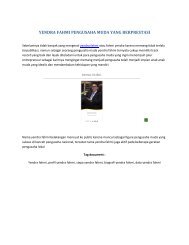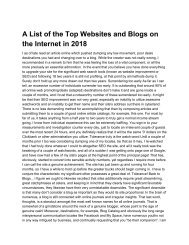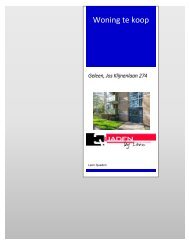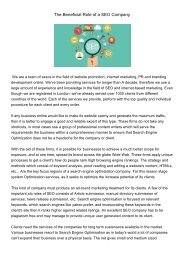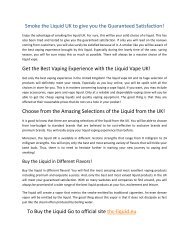best binoculars for this year revealedpdf
Create successful ePaper yourself
Turn your PDF publications into a flip-book with our unique Google optimized e-Paper software.
7 Crucial factors to consider<br />
when searching <strong>for</strong> the right<br />
https://the<strong>binoculars</strong>guy.com/
• The first factor you should think about, is<br />
the magnification of your <strong>binoculars</strong>. Many<br />
people make the mistake of thinking that<br />
the bigger the magnification, the better<br />
the <strong>binoculars</strong>.<br />
• If you are hunting in dense <strong>for</strong>est, perhaps<br />
a 14x or even a 19x would be better <strong>for</strong><br />
your use. If you will be using the <strong>binoculars</strong><br />
<strong>for</strong> watching birds, a magnification of 8x is<br />
a better option.<br />
• If you are looking <strong>for</strong> a good all-round<br />
<strong>binoculars</strong>, a 10x magnification should<br />
work well <strong>for</strong> you.<br />
MAGNIFICATION
OBJECTIVE SIZE<br />
The size of the lens is the objective size. This second part in<br />
the typical 10x42 denotation tells us what the objective<br />
size is <strong>for</strong> a binocular. The value 10 refers to the<br />
magnification. The 42 refers to the objective size as<br />
measured in millimeters(mm).<br />
If you will be travelling with your <strong>binoculars</strong>, you won't<br />
enjoy lugging around a big, heavy set of binos. The smaller<br />
the objective size, the more compact the binos .<br />
For travelling purposes, sporting events, or going to the<br />
opera, you might lean towards a smaller objective size. If<br />
you need a wider field of view, perhaps when hunting, or<br />
viewing panoramas, a larger objective size would suit you<br />
better.
FIELD OF<br />
VIEW<br />
The field of view refers to how wide an area is visible through the<br />
lens at a certain distance. It is a measurement taken at the 1000<br />
feet mark.<br />
For example, the Vanguard Endeavour 10x42 has an incredible field<br />
of view of 374ft. This means that with the Endeavour you can see an<br />
area 374ft wide at a distance of 1000 yards.<br />
A larger magnification means a smaller field of view. A smaller FOW<br />
might not be the right option if you will be viewing fast moving<br />
objects at a distance. For example, wildlife viewing and watching<br />
sports might be better suited to a wider FOW.
PORTABILITY - SIZE<br />
AND WEIGHT<br />
There are an incredible amount of <strong>binoculars</strong> on the market. They<br />
come in every shape and size. It is crucial that you buy a pair that will<br />
suit your needs. You don't want to go travelling with a big and bulky<br />
pair. You don't want to be stuck with a compact bino with too little<br />
magnification when you are out hunting.<br />
As with many of the other factors, you will have to find the perfect<br />
balance <strong>for</strong> your use. Some of the more compact designs, like the<br />
Canon 10x30 IS Ultra-Compact weigh in at just 21ounces. The Canon<br />
only offers 10x30, while the heavier Vortex Diamondback offers<br />
10x42 magnification.
These multiple coatings offer a whole<br />
bunch of benefits, some of these are:<br />
• Promote superior contrast<br />
• Increase in brightness and clarity<br />
• Enhance light<br />
• Keep images true to colour<br />
• Protects the lenses from scratching<br />
• Makes lenses easier to clean<br />
LENS<br />
COATING
EXTRA-LOW<br />
DISPERSION (ED)<br />
GLASS<br />
For the serious binocular enthusiast, ED or extra-low<br />
dispersion glass is a must.<br />
ED glass does vary in quality as there is no industry standard.<br />
A bino with good quality ED glass will reduce chromatic<br />
abberation.<br />
Chromatic abberation is BIG word. It reduces the difference in<br />
wavelength in the image you are viewing.<br />
Bino's with ED glass will reduce <strong>this</strong> effect, <strong>for</strong> a clearer image with<br />
better contrast and high resolution colour.?<br />
Is ED necessary <strong>for</strong> all bino users? No, it definitely is not. A good allround<br />
af<strong>for</strong>dable binocular with ED glass is the Vanguard Endeavour<br />
10x42.
TWILIGHT<br />
FACTOR?<br />
The twilight factor refers to image sharpness and image<br />
detail in low light conditions. A larger twilight factor will<br />
result in a sharper, brighter image in low light conditions.<br />
The picture below shows the difference between a low<br />
and high twilight factor bino.
WHAT DO NUMBERS<br />
MEAN IN BINOCULARS?<br />
Binoculars usually have two numbers such as 7×50 and<br />
16×50. The number be<strong>for</strong>e the × is the magnification<br />
power, while the number after the × is the diameter of the<br />
objective lens in mm.<br />
The first number indicates how the objects will be<br />
magnified. For instance, <strong>binoculars</strong> with a 16×50 lens will<br />
make objects appear 16 times closer.<br />
There<strong>for</strong>e, if you were viewing objects from longer<br />
distances, <strong>binoculars</strong> with great magnification power<br />
would be ideal.
Binoculars Deals<br />
and Discounts<br />
Looking <strong>for</strong> the <strong>best</strong> prices on top rated <strong>binoculars</strong>? ==>> Check<br />
<strong>this</strong> <strong>binoculars</strong> <strong>for</strong> sale page on Amazon<br />
https://the<strong>binoculars</strong>guy.com/
THANKS<br />
https://the<strong>binoculars</strong>guy.com/



